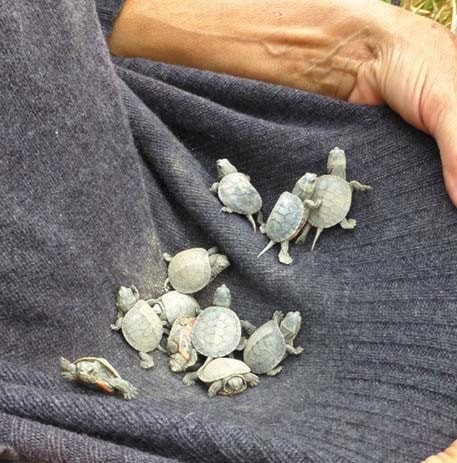Barry Coulter
Cranbrook is located in the heart of a lush part of the planet, teeming with an astounding variety of flora, fauna and geography that many of us, perhaps, take for granted.
Cranbrook's interest in the natural world around it is on the increase. And for more than 30 years, a key community organization has served as our go-to interpreter of this world.
While many regional nature clubs have faded away, the Rocky Mountain Naturalists are thriving, with 20 new members in the last year alone. This is largely because community is a big part of their mission.
"We want to embrace the community, and the community is responding," said Greg Ross, a club director.
The Rocky Mountain Naturalists are about learning about nature, being out in nature, and sharing that knowledge with others. The group is about sharpening and enjoying their powers of observation, and helping others to sharpen those powers.
One thing about this is that only a little experience can lead to immediate knowledge, but that storage of knowledge can be infinite.
"We set out 20 years ago to learn about the trees in this area, for example," Ross said. "And we're still learning."
To further its goals, the club participates in a number of outdoor activities — viewing and studying birds, plants, mammals, insects, fossils, geology, and other aspects of our natural world.
When it comes to new members versus old members, the knowledge flows both ways.
"We ask new people, when they come out, to help teach the older members by asking questions," Ross said. "When new members come out, we want them to know that asking questions (that some times may seem silly) helps everyone, including the older members to learn.
"On a recent hike, for example, we asked a new couple to do a short presentation on the four main differences between hares and rabbits."
Later on, another member gave a short, fascinating talk regarding some of the local weasels and their folklore.
"It's citizen science," said member Daryl Calder.
 Pictured: Learning to Fly, by Lyle Grisedale.
Pictured: Learning to Fly, by Lyle Grisedale.
The formation of the Rocky Mountain Naturalists occurred around the same time as the creation of Elizabeth Lake — a wetland on the edge of Cranbrook — as a wildlife sanctuary. Calder says the lake and adjacent area is perfectly situated for its purpose. It is on a main, north-south branch of the Pacific Flyway — a major migratory path — offering birds a fine spot to touch down, rest, feed and perhaps find a mate and stay awhile to raise their young.
But, Calder says, at one time the fate of the wetland was in doubt. The City of Cranbrook was considering draining and filling it in for development. It was used as a dumping ground, and motorized recreationalists were having their way with it.
But over the past 30 years, it has become the noted regional wildlife sanctuary it is now, with various stakeholders taking part in its interests, including the City of Cranbrook, the RDEK, Ducks Unlimited, and The Land Conservancy. The Rocky Mountain Naturalists themselves are key stewards of Elizabeth Lake, involved in trail building and maintenance, signage, monitoring and maintaining the nest sites for the endangered western painted turtles, monitoring bird populations, and creating and maintaining nesting boxes and bird blinds.
 Pictured: Our ovine neighbours, by Lyle Grisedale.
Pictured: Our ovine neighbours, by Lyle Grisedale.
Generally speaking the busiest, most rewarding times for local nature observers occur on the cusps — times of change between the seasons, for example, or on the boundaries between biogeoclimatic zones, of which there are an immense variety in southeastern B.C. The Fort Steele area, for example, differs from Cranbrook and Kimberley because of lower elevation, enhanced rain shadow effect (drier and sunnier), more extensive grasslands, and because of the Kootenay and St Mary rivers. The differences between the West Kootenay and East Kootenay zones can be quite profound.
"That's when, and where, activity really picks up," Ross said.
All these factors make the RMN a four-season club. Notable in this regard is the Club's annual Christmas Bird Count, part of the continent-wide Audubon Christmas Bird Count (in this country, run under the auspices of Bird Studies Canada). This count, which is also conducted in Creston, Kimberley, Invermere and Fernie, covers an area 25 kilometres in diameter, centred at the Visitors' Information Centre at Elizabeth Lake. The count, Calder explains, helps to fine-tune the inventory of bird populations, keep track of migratory patterns — who migrates, who does not, who actually migrates from the north to spend the winter here.
"(The bird count) is also an opportunity for people who are interested in nature to meet and take part," Calder said.
Throughout the year, the club hosts walks to view and identify birds, conducts early morning birding surveys at Elizabeth lake, conducts breeding bird surveys and owl surveys for Bird Studies Canada.
But the birds are only a portion of the club's activities. The Naturalists conduct trips to view and identify wildflowers in different seasons and specific types of shrubs, fungi, lichens. They locate and identify the largest trees of each species with conservation aims. They conduct fossil and animal track excursions (the latter is a winter activity), build bat boxes and bluebird boxes, and are looking to get to into astronomical activities, with night sky identification.
The Rocky Mountain Naturalists hold bi-monthly meetings, which often include guest speakers. As well their scheduled outings in the backcountry, they club also holds an annual family-friendly camp — this year set for Blue Lake.
As well, the club is under the umbrella of BC Nature, a naturalist group which is active in the fields of conservation, education, and outdoor recreation. Membership in the RMN gives access to all the activities and resources of the province-wide club.
For more information, or to view the club's newsletter "The Kestrel," check out www.rockymountainnaturalists.org.
